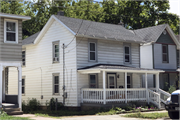Property Record
633 E. Johnson Street
Architecture and History Inventory
| Historic Name: | Benjamin and Amy Butts House |
|---|---|
| Other Name: | |
| Contributing: | |
| Reference Number: | 241094 |
| Location (Address): | 633 E. Johnson Street |
|---|---|
| County: | Dane |
| City: | Madison |
| Township/Village: | |
| Unincorporated Community: | |
| Town: | |
| Range: | |
| Direction: | |
| Section: | |
| Quarter Section: | |
| Quarter/Quarter Section: |
| Year Built: | 1870 |
|---|---|
| Additions: | |
| Survey Date: | 2019 |
| Historic Use: | house |
| Architectural Style: | Side Gabled |
| Structural System: | |
| Wall Material: | Aluminum/Vinyl Siding |
| Architect: | |
| Other Buildings On Site: | |
| Demolished?: | No |
| Demolished Date: |
| National/State Register Listing Name: | Not listed |
|---|---|
| National Register Listing Date: | |
| State Register Listing Date: |
| Additional Information: | City of Madison, Wisconsin Underrepresented Communities Historic Resource Survey Report: Benjamin Butts was born enslaved in Petersburg, Virginia in 1853. When the Fifth Wisconsin Battery occupied the town in 1864, Benjamin joined them and eventually returned to Richland Center, Wisconsin with Major Cyrus Butts. Benjamin took his surname and worked in his household until he was of age to leave. In approximately 1870, Butts moved to Madison. Employment opportunities for African Americans were limited, and often only included manual labor and service jobs. Benjamin worked as a porter, a clerk, and finally a barber. He was successful and opened his barbershop in 1872 at the non-extant 5 Pickney Street catering to Madison’s political elites as clients including Governors Rusk, Washburn, Taylor, Smith, Fairchild, and Peck. Through this work, he made extensive social connections and worked as a doorman and butler at official government functions at the state capitol and private parties in the Mansion Hill neighborhood. In 1888, Benjamin married Amy Roberts. The couple lived in a non-extant apartment at 86 East Gorham Street and had eight children, while only five survived infancy. In 1892, the family moved to a larger house at 633 East Johnson Street, northeast of the Capitol Square, which they rented. At the time, approximately 41 African Americans were living in the city. Benjamin Butts was influential as a leader of the small African American community as it grew into the twentieth century, particularly around East Johnson, Dayton, and Mifflin Streets. When the Wisconsin Historical Society opened its large new building at 816 State Street in 1900 on the University of Wisconsin-Madison campus, Butts was hired as a messenger, doorman, and janitor given his knowledge of Madison and the city’s legislators and university faculty. In 1907, the Butts family moved again to a non-extant house at 639 East Dayton Street, where they lived until Benjamin and Amy died in 1930. Benjamin’s son, Leo, who was born in 1898, became the first Black football player on the University of Wisconsin-Madison’s college team. He played his first game for the Badgers during the second game of the 1918 season against Beloit College. Leo Butts was also the first African American to graduate from the University of Wisconsin School of Pharmacy in 1920. After graduating, he moved to Gary, Indiana where he became a druggist. |
|---|---|
| Bibliographic References: |
| Wisconsin Architecture and History Inventory, State Historic Preservation Office, Wisconsin Historical Society, Madison, Wisconsin |

